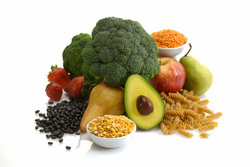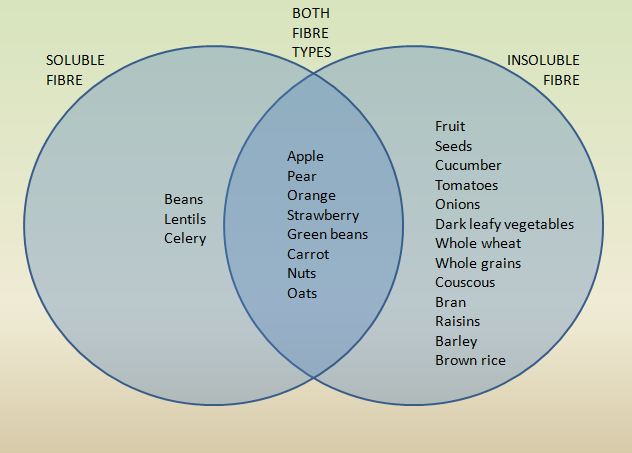
By Dr Harry
Fibre is an essential component of the diet. Even though it is not absorbed by the body, and therefore has no nutritional value on its own, fibre is vital to maintain a healthy digestive system. Another way fibre helps your health is by adding bulk to your food. These two features of fibre illustrate the two different types of fibre: soluble and insoluble. Soluble Fibre Like the name suggests, soluble fibre dissolves in water. It comes from parts of plants which draw in water and by forming a gel helps slow down the passage of food. So when it sits in your stomach it stays there for longer helping you feel fuller and reducing overconsumption. In this way fibre is a great brake on overeating by making you feel full and satisfied helping to control your appetite. That's why it is so difficult to eat a whole bowl of cabbage. Insoluble Fibre Insoluble fibre does not dissolve in water and passes through the body unchanged. Because it helps food to pass through the body in a timely manner, if you don't get enough fibre in your diet you may feel constipated!
My wife and I have recently upped our fibre intake considerably by eating a lot more legumes.
Many people get a high fibre hit first thing in the morning by eating cereals such as bran flakes, weet-a-bix, shredded wheat etc. for breakfast because these are marketed as "high fibre". Personally, we like oats because oats are a great source of fibre but are also low in sugar and salt (which the other cereals mentioned tend to have added to make them more tasty). So oats are all-round very healthy. You can read our blog dedicated to oats here.
The recommended daily intake of fibre is 25g for women and up to 40g for men. Exact figures depend on age and gender, but a general rule is: the more the better! Unfortunately according to the British Nutrition Foundation, we are usually missing out on this daily target, only eating 60% of the recommended amount of fibre per day. Over time, this can have a negative health impact.
One way to get some extra fibre in your diet is to increase the amount of fruit and vegetables you consume. For example, why not add a sliced kiwi to your breakfast routine? The exact amount of fibre per food varies, but a minimum should be 3g per 100g (or 3%) to count towards your daily fibre intake. Some foods are "high" in fibre which is defined as 6g of fibre per 100g (i.e. 6%). Fruit and vegetables are generally high in fibre, so as long as you are getting your "five-a-day" you should meet your daily fibre target. Foods high in fibre:
Some foods are higher in insoluble fibre while others are higher in soluble fibre. Since they both have a positive effect, it's best to get a mixture in your diet. Some super foods are high in both insoluble and soluble fibre. You may not be surprised to learn that oats contain both types of fibre. Insoluble fibre is that which is based on cellulose - a plant component found in green vegetables and whole grains. Soluble fibre is based on pectin and gums and is found in all fruits. And by the way, chips don't count - unless they contain the potato skin! 
Although your personal finances and your business success are my primary interest, I believe you only operate at peak efficiency when you're fit and healthy. If you feel good, it filters through to your work. To help you with that, click for your free ebook: The Quick Guide to Sexy
0 Comments
Leave a Reply. |
By Heather
|
Heather Katsonga-Woodward, a massive personal finance fanatic.
** All views expressed are my own and not those of any employer, past or present. ** Please get professional advice before re-arranging your personal finances.


 RSS Feed
RSS Feed


